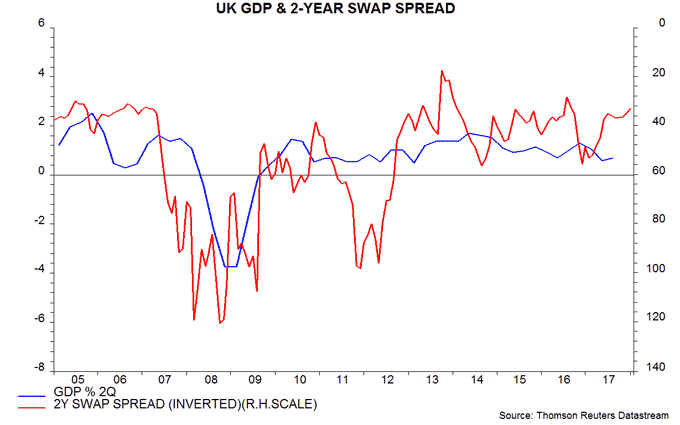UK data revisions positive, money trends stable
The Office for National Statistics presented a pre-Christmas gift to economic optimists by upgrading GDP numbers for 2016-17 while indicating that the balance of recent growth has been more favourable than previously reported. Current monetary trends suggest that economic expansion will remain respectable in 2018.
The revisions boosted annual GDP growth in the first three quarters of 2017 by 0.3%, 0.4% and 0.2% respectively. Full-year growth is now on course to be 1.8% – significantly better than a consensus forecast of 1.2% at the start of 2017*.
From the expenditure side, the upgrade reflected stronger net exports and fixed investment, which offset weaker household consumption than previously reported.
From the output side, industrial and construction sector growth was revised higher, with services expansion unchanged.
According to the new data, the improvement in net export performance in 2017 was impressive and has offset a significant slowdown in household consumption, with business investment growth modest but stable – see first chart. Overall investment growth has been slightly higher because of a strong housing contribution.

The rise in net exports has probably been driven by the divergence between strong growth in foreign markets and subdued domestic demand, rather than a competitiveness boost from the fall in sterling. Exporters have adjusted sterling prices to offset most of the impact of the depreciation: the deflator for exports of goods and services rose by 10% between the first quarter of 2016 and third quarter of 2017 versus a 12% fall in the effective exchange rate over the same period,
Bank of England monetary data for November released yesterday suggest that economic expansion will continue at around its recent pace through summer 2018. Six-month growth rates of real (i.e. consumer price-deflated) narrow and broad money have been little changed since June 2017, having bottomed in April – second chart.

The rise in real narrow money growth since April 2017 reflects a modest recovery in the household component, which had weakened significantly in late 2016 / early 2017, warning of a consumption slowdown. This recovery suggests that consumer prospects are improving at the margin.
Real narrow money holdings of private non-financial corporations (PNFCs), meanwhile, continue to grow solidly, suggesting stable or stronger business investment expansion.
As in 2017, construction activity may support overall investment. New construction orders surged by 37% in the third quarter of 2017, reflecting the awarding of HS2 contracts. The associated construction is not scheduled to start before late 2018 but non-infrastructure orders also rose, while the new orders component of the construction purchasing managers’ survey increased to a seven-month high in December.
The signal that overall growth will hold up in 2018 is supported by a narrowing of the two-year swap spread, which has been an inverse leading indicator of economic performance historically – third chart.

These developments suggest upside risk to the current consensus forecast of only 1.4% GDP growth in 2018.
*Consensus forecast from Treasury’s monthly survey.

Reader Comments